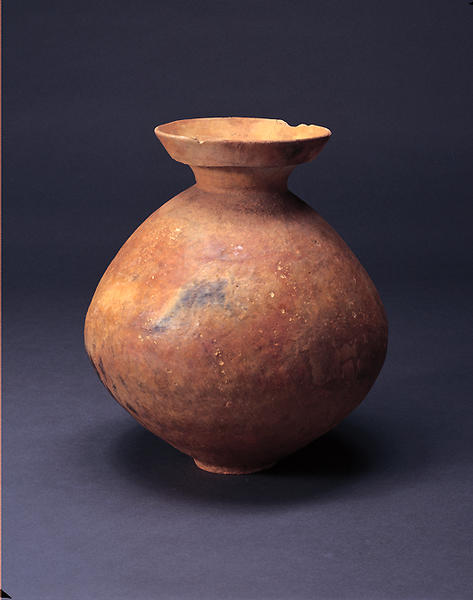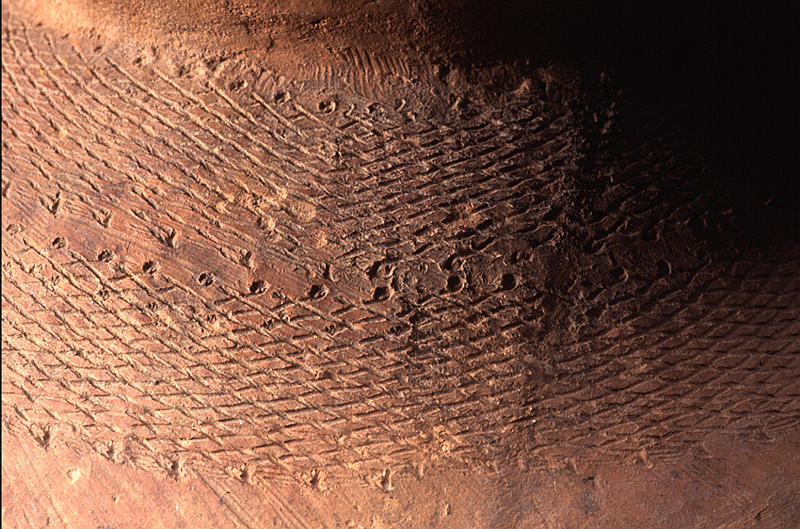土師器丹彩壺
- 古墳時代初期
- 4c
- 朱彩素焼
- H-44 D-39
古墳時代初期 4世紀
高:44.0cm 口径:23.0cm 胴径:39.0cm 底径:11.0cm
古墳時代初期の土師器は弥生時代の土器の系譜をそのまま引いており,壷・甕・鉢・高杯・椀などの日常生活容器を中心として焼いているが,弥生土器後期から始まった無文化の傾向は土師器になるといっそう顕著になる。この壷はまだ底部が平底であるが,短く外に開く口頚部が途中から屈折して斜め上方に立ち上がり,二重口縁の形態をとっていて,その形から見て土師器の段階に入るものと思われる。口頚部や胴下半にまだ膨らみを残している形態から見て,東海地方東部,駿河湾沿岸地域のものかと考えられる。東海地方の土師器初期の元屋敷期に相当する時期のものである。
この壷は口頚部と肩のやや下がったところから底部にかけて朱彩を施している。肩の上部を塗り残しているのは弥生土器終末期の施文部を意識したものであろう。東海地方の弥生土器ではこの部分に櫛描文や鋸歯文を施したものが多い。また,底部の黒ずんだ部分に粗い網状圧痕が残されている。
弥生時代後期から古墳時代初期にかけて作られた,このような朱彩の大型壷は祭祀用具として用いられたと考えられる。(楢崎)
Catalogue Entry
Early Kofun period, 4th century
Haji ware with tan red pigments
Height, 44.0cm; mouth diameter, 23.0cm;
torso diameter, 39.0cm; base diameter, 11.0cm
Haji ware ceramics produced in the early Kofun period were a continuation of the bisque wares produced during the Yayoi period and mainly consisted of vessels for everyday use, whether jars, jugs, cooking bowls, pedestals, or bowls. These wares extended and expanded the trend for undecorated forms that had begun in the late Yayoi bisque wares. While the base of this jar is still flat, the low, flaring mouth is sharply step-ped at one point and expands diagonally upward. This double-layered neck and mouth indicates that this jar was produced in the Haji ware stage. The neck-mouth area and the swell that remains in the lower half of the torso indicate that this work was probably produced in the eastern part of the Tokai region, most likely along the coast of Suruga Bay. This accords with the Motoyashiki period of the early production of Haji wares in the Tokai region.
This jar is decorated with a red pigment that extends from just below the neck and shoulders to its base. The top of the shoulders were left uncoated, and this probably indicated an awareness of the fact that this area was normally the section used for decorative patterns at the end of the Yayoi bisque ware period. In Tokai region Yayoi bisque wares, this section would frequently have been decorated with either combed or saw-tooth patterns. The blackened area around the base still shows the traces of a rough net pattern.
This type of large, red-pigmented jar made from the end of the Yayoi period to the beginning of the Kofun period is thought to have been used as a ritual utensil in festivals or rites. SN

